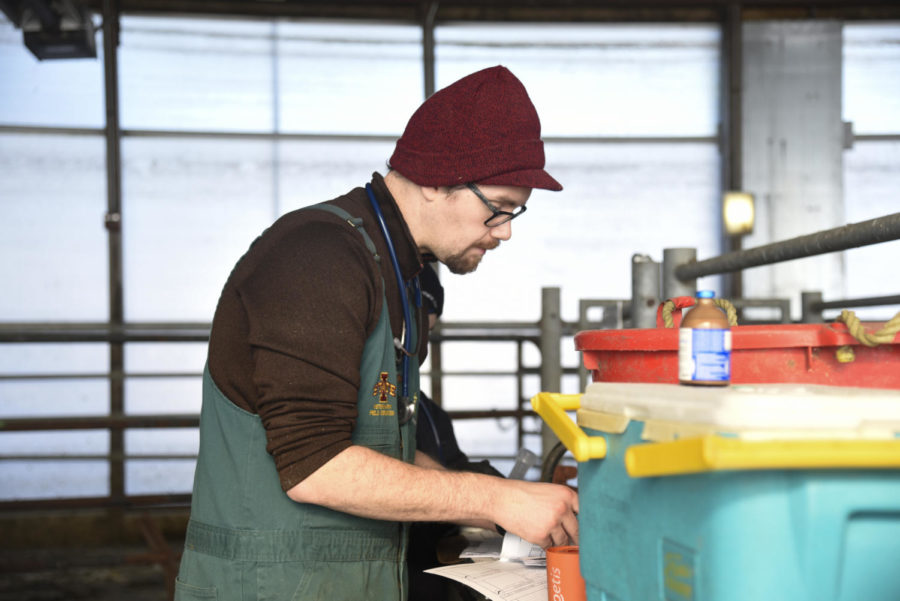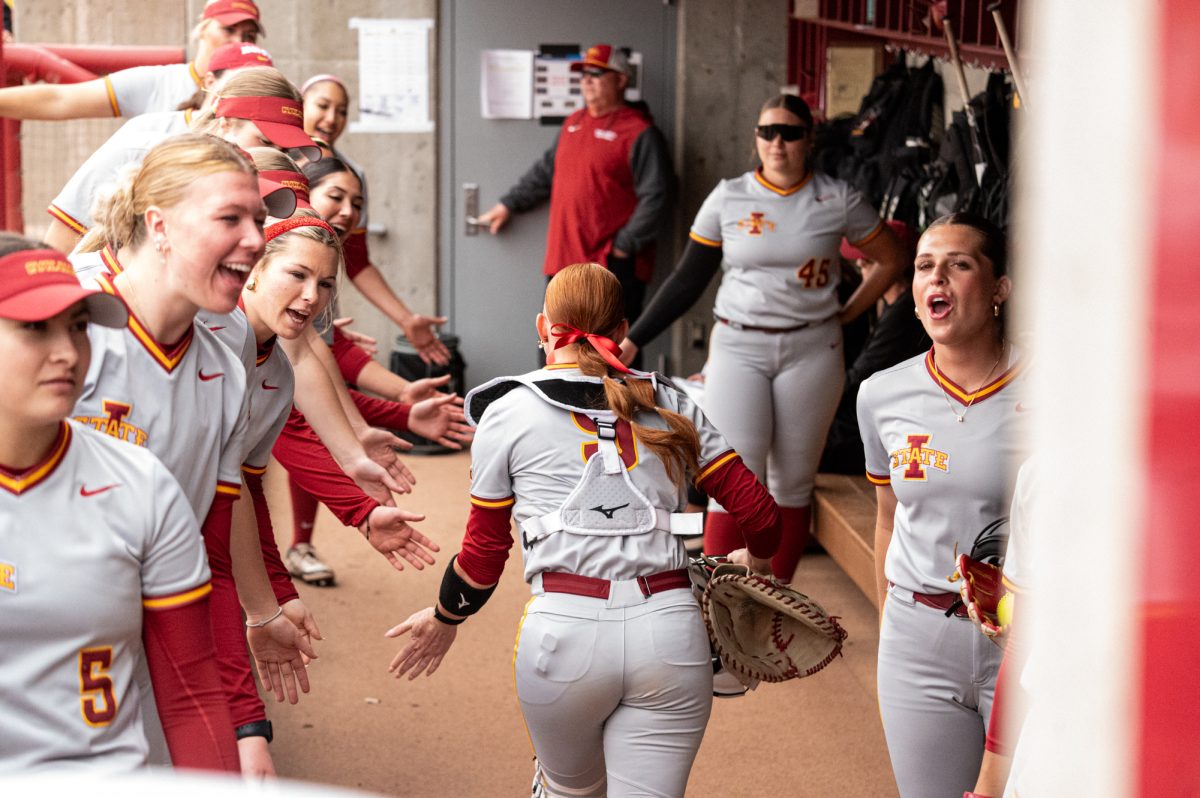Field Services provides support to local farms (copy)
December 3, 2019
Within the College of Veterinary Medicine, fourth year students can receive practical hands-on training by treating farmers’ livestock through a Field Services rotation.
Troy Brick is the lead veterinarian of Field Services and assistant professor of veterinary diagnostic and production animal medicine. Brick guides students in the Field Service clinic’s program to give veterinary students the opportunity to take off-campus house calls to farms around the area.
“We sit in a unique position because we’re one of the few real businesses here on campus that has to operate like a business,” Brick said. “But we have to run in the confines of a university system.”
Brick said the Field Services’ clinic is a two-week rotation provided to four fourth year veterinary medicine students at a time and serves clients with food animals and camelids.
“If you eat or wear it, we look at it,” Brick said. “We operate as a typical farm animal, except for equine, clinic.”
Equine Field Services, another two-week rotation offered to fourth year veterinary medicine students, operates as an entity separate from Brick’s Field Services rotation.
Brick said the two-week rotation usually begins with a PowerPoint brief giving an overview of the rotation, then at least one student and clinician is sent to the ISU Dairy Farm to conduct rounds on the cows.
“One of us, the clinicians or the post-docs and at least one of the students every day of the year, 365 days a year, do the treatments out at the ISU Dairy [Farm] to any sick or potentially sick cows,” Brick said.
The ISU Dairy Farm has between five and 15 sick cows that require treatment, said Austin Ashbacher, fourth year veterinary student.
Some common conditions of the cattle treated at the ISU Dairy Farm, include mastitis (inflammation of the udder), retained placenta during birthing and lameness, Ashbacher said.
The other standing appointment held by the college involves a trip outside the Field Services clinic’s usual area of operation to treat calves in western Iowa.
“On Tuesdays every week there’s two clinicians and a group of students that go out to western Iowa to the Harlan area and visit two [places], one very large and then one smaller dairy [farm], to do herd health,” Brick said.
Ashbacher said going to western Iowa and getting to perform pregnancy checks on the animals was one of his favorite experiences in the Field Services rotation.
“We go in rectally with our arm and we reach down and feel [the uterus] through the rectal wall, and you can tell if she’s pregnant or not,” Ashbacher said. “It’s a very hard skill to learn.”
Ashbacher said getting to perform pregnancy checks on hundreds of cows in western Iowa helped him perfect the skill and give him confidence in his abilities.
Amanda Farmer, fourth year veterinary medicine student, also partook in the Field Services rotation in the fall. She recalled getting to perform a cryptorchid castration on a pig.
Farmer said a cryptorchid castration is a slightly unusual procedure where one of the testicles is located in the abdomen.
“That was really cool to see because I, personally, haven’t had a lot of experience with pigs, so getting to go to the barn and help with the procedure was really cool,” Farmer said. “I enjoyed that a lot.”
The veterinarians who work with Field Services work with the students to guide them throughout the visits and performed procedures.
“The doctors help to calm you down,” Farmer said. “They do a good job of talking through it and what to expect and what you might see and what could go wrong. It’s a really good environment for learning because everyone is a little nervous the first time you do something.”
The variety of the work client services performs leads to students entering the two-week rotation at different times of the year to gain more hands-on experience with different types of situations, Brick said
The Field Services’ clinic also provides emergency services to its clients. At least one student and one clinician is on-call 24 hours a day every day of the week.
Farmer said one night while on call, she had to respond to three emergencies, all related to problems with cows. The third emergency involved a cow with dystocia, or difficulty birthing.
“We couldn’t get the cow the normal way, so we went for c-section,” Farmer said. “Unfortunately, the calf was dead and the cow was so sick by the time we got there that she had to be put down later.”
Farmer said it is tough being called to work in the middle of the night for emergencies, but it happened to be one of the times where she learned the most during the rotation.
Ashbacher said on the first day of the rotation, the four students collaborate to put together the shifts for on-call time themselves.
“Nobody was trying to skimp out on on-call time,” Ashbacher said. “No matter what rotation you’re on, as long as everybody is working together and helping each other, things go so much better.”
When going out on calls, Ashbacher said most farmers have become accustomed to working with students and are very receptive.
“For the most part I think [farmers] are very warm and take some sense of pride from participating,” Farmer said. “I think the clients are very happy to have us help out and learn.”
Ashbacher said he remembers having the opportunity to perform a displaced abomasum surgery during the Field Services rotation.
“A [displaced abomasum] is when one of [a cow’s] stomach twists and you have to go in and surgically correct it,” Ashbacher said. “The cow is standing up. She’s fully awake, but you’ve made this incision in her side and you got your arm reached all the way into the animal.”
Ashbacher said a numbing agent, lidocaine, is used to numb a nerve and prevent the animal from negatively reacting to the operation in most cases. Ashbacher said he felt lucky to have the opportunity to perform the operation, despite some jitters, and he was able to successfully perform the surgery.
“The average person probably doesn’t realize we do something like that,” Ashbacher said.
Brick said when students are unable to perform a specific procedure due to the timing of their rotation, he turns to the use of models to provide students with the hands-on training they need.
The Field Services’ clinic currently uses a model of a cow giving birth to give students the opportunity to practice birthing a calf when they may not be able to during their rotation.
Brick said he plans to continue the use of models with Field Services students for another procedure as well.
“Everybody is going to be expected to be able to castrate calves,” Brick said. “That only comes once or twice a year, so I’m working on a calf castration model. […] We’re really close to having a usable model.”
Ashbacher said he advised students who consider taking the Field Services rotation to keep an open mind.
“Every day is gonna be a little different,” Ashbacher said. “A lot of people taking it might not have much ambition to be doing cattle or goat or sheep work […] but I think there’s a lot to be learned in that realm that can make you better at whatever your specialty is going to be.”
Farmer said she recommends people who are interested in veterinary medicine to get all the experience they can.
“Get in touch with your local vet and ride with them and get a feel of what they do,” Farmer said. “That clinical experience, like hands on, helps you when you’re in school because you can listen during your lectures and apply it.”
Farmer also said aspiring veterinary students should keep a good attitude through hard work.
“Some days are harder than others,” Farmer said. “You might have to put an animal to sleep or something like that, but just remembering why you’re doing it and keeping a positive attitude will help you get through it.”







